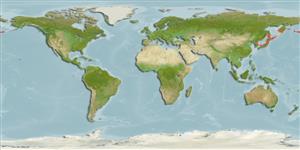Environment: milieu / climate zone / depth range / distribution range
Écologie
marin démersal; profondeur 150 - 250 m (Ref. 83439). Temperate
Northwest Pacific: known only from the Sea of Japan, Sea of Okhotsk, and Pacific coast of Hokkaido.
Taille / Poids / Âge
Maturity: Lm ? range ? - ? cm
Max length : 10.0 cm SL mâle / non sexé; (Ref. 559)
Description synthétique
Clés d'identification | Morphologie | Morphométrie
Épines dorsales (Total) : 7; Rayons mous dorsaux (Total) : 10 - 12; Rayons mous anaux: 11 - 13. This species is distinguished by the following set of characters: simple nasal spines; almost straight uppermost preopercular spine with 2 small cusps dorsally and barbed posterior cusp; elongated first dorsal fin in males; lateral line reaching almost base of caudal fin; with ventral lateral cirrus (Ref. 83439).
Usually occurs on sandy-muddy bottoms (Ref. 83439).
Life cycle and mating behavior
Maturité | Reproduction | Frai | Œufs | Fécondité | Larves
Masuda, H., K. Amaoka, C. Araga, T. Uyeno and T. Yoshino, 1984. The fishes of the Japanese Archipelago. Vol. 1. Tokai University Press, Tokyo, Japan. 437 p. (text). (Ref. 559)
Statut dans la liste rouge de l'IUCN (Ref. 130435: Version 2024-2)
Menace pour l'homme
Harmless
Utilisations par l'homme
Outils
Articles particuliers
Télécharger en XML
Sources Internet
Estimates based on models
Preferred temperature (Ref.
123201): 0.7 - 7.6, mean 2 °C (based on 27 cells).
Phylogenetic diversity index (Ref.
82804): PD
50 = 0.6250 [Uniqueness, from 0.5 = low to 2.0 = high].
Bayesian length-weight: a=0.00955 (0.00344 - 0.02648), b=3.09 (2.85 - 3.33), in cm total length, based on LWR estimates for this (Sub)family-body shape (Ref.
93245).
Niveau trophique (Ref.
69278): 3.3 ±0.5 se; based on size and trophs of closest relatives
Résilience (Ref.
120179): Milieu, temps minimum de doublement de population : 1,4 à 4,4 années (Preliminary K or Fecundity.).
Fishing Vulnerability (Ref.
59153): Low vulnerability (10 of 100).
